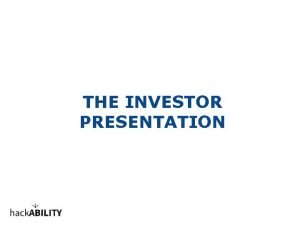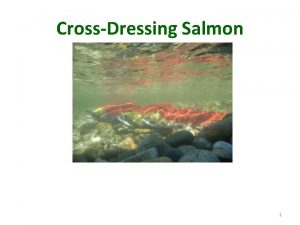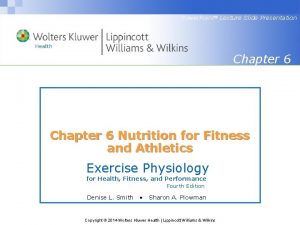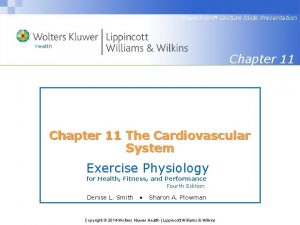Power Point Lecture Slide Presentation Chapter 1 The
































- Slides: 32

Power. Point® Lecture Slide Presentation Chapter 1 The Warm-Up Exercise Physiology for Health, Fitness, and Performance Fourth Edition Denise L. Smith • Sharon A. Plowman Copyright © 2014 Wolters Kluwer Health | Lippincott Williams & Wilkins

Chapter 1 The Warm-Up I. What is Exercise Physiology? Exercise Physiology is both a basic and applied science that describes, explains, and uses the body’s response to exercise and adaptation to exercise training to maximize human physical potential Copyright © 2014 Wolters Kluwer Health | Lippincott Williams & Wilkins

Chapter 1 The Warm-Up II. Overview of Textbook A. Consistent order of presentation 1. Basic science 2. Exercise response 3. Application of training principles 4. Training adaptations, and 5. Special concerns (health-related) Copyright © 2014 Wolters Kluwer Health | Lippincott Williams & Wilkins

Chapter 1 The Warm-Up B. Organized according to body systems Copyright © 2014 Wolters Kluwer Health | Lippincott Williams & Wilkins

Chapter 1 The Warm-Up III. Exercise Response Exercise - A single acute bout of bodily exertion or muscular activity that requires expenditure of energy above resting level and that in most cases results in voluntary movement Exercise Response - The physiological responses which occur during or immediately following an acute bout of exercise Copyright © 2014 Wolters Kluwer Health | Lippincott Williams & Wilkins

Chapter 1 The Warm-Up Can be described based on 3 factors A. Exercise modality (mode) type of activity or sport • Energy demand (aerobic or anaerobic) • Type of muscle action (continuous, rhythmical or resistance, or static) Copyright © 2014 Wolters Kluwer Health | Lippincott Williams & Wilkins

Chapter 1 The Warm-Up B. Exercise intensity a. Maximal b. Submaximal - Absolute workload - Relative workload C. Exercise duration Copyright © 2014 Wolters Kluwer Health | Lippincott Williams & Wilkins

Chapter 1 The Warm-Up IV. Exercise Categories A. Short-term, light to moderate submaximal aerobic exercise 10 -15 min ~30 -69% of maximal work capacity Copyright © 2014 Wolters Kluwer Health | Lippincott Williams & Wilkins

Chapter 1 The Warm-Up B. Long-term, moderate to heavy submaximal aerobic exercise 30 -240 min ~55 -89% of maximal work capacity Copyright © 2014 Wolters Kluwer Health | Lippincott Williams & Wilkins

Chapter 1 The Warm-Up C. Incremental aerobic exercise to maximum Progresses in stages from light to maximal Copyright © 2014 Wolters Kluwer Health | Lippincott Williams & Wilkins

Chapter 1 The Warm-Up D. Static exercise Described as a percent of maximal voluntary contraction (%MVC) Copyright © 2014 Wolters Kluwer Health | Lippincott Williams & Wilkins

Chapter 1 The Warm-Up E. Dynamic resistance exercise Described as a percent of maximal weight that can be lifted (1 -RM) and number of times lifted. Copyright © 2014 Wolters Kluwer Health | Lippincott Williams & Wilkins

Chapter 1 The Warm-Up F. Very short-term, high intensity anaerobic exercise Often supramaximal when compared to maximal aerobic capacity Copyright © 2014 Wolters Kluwer Health | Lippincott Williams & Wilkins

Summary of Exercise Responses Copyright © 2014 Wolters Kluwer Health | Lippincott Williams & Wilkins

Chapter 1 The Warm-Up V. Exercise Response Patterns Copyright © 2014 Wolters Kluwer Health | Lippincott Williams & Wilkins

Chapter 1 The Warm-Up Copyright © 2014 Wolters Kluwer Health | Lippincott Williams & Wilkins

Chapter 1 The Warm-Up VI. Exercise Response Interpretations Based on: 1. Characteristics of the exerciser 2. Appropriateness of the selected exercise 3. Accuracy of the selected exercise 4. Environmental and experimental conditions Copyright © 2014 Wolters Kluwer Health | Lippincott Williams & Wilkins

Chapter 1 The Warm-Up VII. Training - A consistent or chronic progression of exercise sessions designed to improve physiological function for better health or sport performance Copyright © 2014 Wolters Kluwer Health | Lippincott Williams & Wilkins

Chapter 1 The Warm-Up A. Health-Related vs. Sport-Specific Physical Fitness - A physiological state of well-being that provides the foundation for the tasks of daily living, a degree of protection against hypokinetic disease, and a basis for participation in sport Copyright © 2014 Wolters Kluwer Health | Lippincott Williams & Wilkins

Chapter 1 The Warm-Up HRPF - That portion of physical fitness directed toward the prevention of, or rehabilitation from, disease as well as the development of a high level of functional capacity for the necessary and discretionary tasks of life SSPF - That portion of physical fitness directed toward optimizing athletic performance Copyright © 2014 Wolters Kluwer Health | Lippincott Williams & Wilkins

Chapter 1 The Warm-Up Copyright © 2014 Wolters Kluwer Health | Lippincott Williams & Wilkins

Chapter 1 The Warm-Up B. Dose-Response Relationships What are the health benefits (or performance benefits) of varying amounts of exercise? Copyright © 2014 Wolters Kluwer Health | Lippincott Williams & Wilkins

C. Training Principles 1. Specificity 2. Overload 3. Rest/Recovery/Adaptation 4. Progression 5. Retrogression/Plateau/Reversibility 6. Maintenance 7. Individualization 8. Warm-Up/Cool-Down Copyright © 2014 Wolters Kluwer Health | Lippincott Williams & Wilkins

D. Periodization • A plan for training based on a manipulation of the fitness components with the intent of peaking the athlete for the competitive season or varying health-related fitness training in cycles of harder or easier training. Copyright © 2014 Wolters Kluwer Health | Lippincott Williams & Wilkins

Periodization Phases 1. General Preparatory phase (off-season) 2. Specific Preparatory phase (preseason) 3. Competitive phase (in-season) 4. Transition phase (active rest) Copyright © 2014 Wolters Kluwer Health | Lippincott Williams & Wilkins

Copyright © 2014 Wolters Kluwer Health | Lippincott Williams & Wilkins

E. Training Adaptations Copyright © 2014 Wolters Kluwer Health | Lippincott Williams & Wilkins

VIII. Detraining • Detraining is the partial or complete loss of training -induced adaptations as a result of a training reduction or cessation Copyright © 2014 Wolters Kluwer Health | Lippincott Williams & Wilkins

IX. Exercise & Training as Stressors A. Selye’s Theory of Stress Stages 1. Alarm-Reaction: Shock and Countershock 2. Stage of Resistance 3. Stage of Exhaustion Copyright © 2014 Wolters Kluwer Health | Lippincott Williams & Wilkins

B. Selye’s Theory Applied to Exercise and Training Copyright © 2014 Wolters Kluwer Health | Lippincott Williams & Wilkins

C. Training Adaptations & Maladaptations • Overreaching: a short-term decrement in performance capacity that is easily recovered from and generally lasts only a few days to 2 weeks. • Overtraining syndrome (OTS): state of chronic decrement in performance and ability to train, in which restoration may take several weeks, months, or even years. Copyright © 2014 Wolters Kluwer Health | Lippincott Williams & Wilkins

Copyright © 2014 Wolters Kluwer Health | Lippincott Williams & Wilkins
 Heel and toe step
Heel and toe step Power point.com
Power point.com 01:640:244 lecture notes - lecture 15: plat, idah, farad
01:640:244 lecture notes - lecture 15: plat, idah, farad Ppt on hindi topics
Ppt on hindi topics Power point presentation design west vancouver
Power point presentation design west vancouver The real lesson 21
The real lesson 21 Power bi training powerpoint
Power bi training powerpoint Point point power
Point point power Lecture presentation software
Lecture presentation software Power system dynamics and stability lecture notes
Power system dynamics and stability lecture notes Zline 667-36
Zline 667-36 Power semiconductor devices lecture notes
Power semiconductor devices lecture notes Switch mode power supply lecture notes
Switch mode power supply lecture notes Power system dynamics and stability lecture notes
Power system dynamics and stability lecture notes Customs in things fall apart
Customs in things fall apart Slide divide factoring
Slide divide factoring Presentation outline slide
Presentation outline slide Housekeeping slide for presentation
Housekeeping slide for presentation Welcome slide for presentation
Welcome slide for presentation Allppt layout clean text slide for your presentation
Allppt layout clean text slide for your presentation Allppt layout clean text slide for your presentation
Allppt layout clean text slide for your presentation Allppt layout clean text slide for your presentation
Allppt layout clean text slide for your presentation Change colors of image
Change colors of image Allppt layout clean text slide for your presentation
Allppt layout clean text slide for your presentation For educational purposes only disclaimer
For educational purposes only disclaimer Acknowledgement ppt slides
Acknowledgement ppt slides Allppt layout clean text slide for your presentation
Allppt layout clean text slide for your presentation Which statement best describes a good presentation slide?
Which statement best describes a good presentation slide? Final presentation slide
Final presentation slide Http://www.free facebook.com
Http://www.free facebook.com Allppt layout clean text slide for your presentation
Allppt layout clean text slide for your presentation Allppt layout clean text slide for your presentation
Allppt layout clean text slide for your presentation Allppt layout clean text slide for your presentation
Allppt layout clean text slide for your presentation
























































